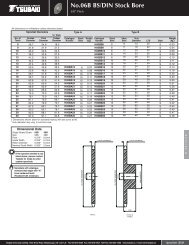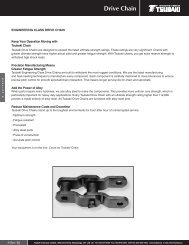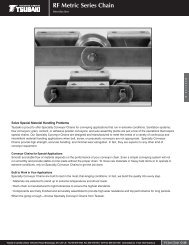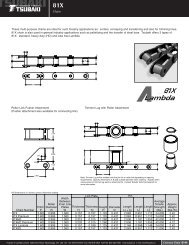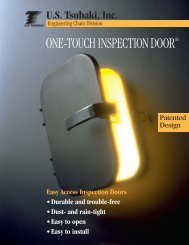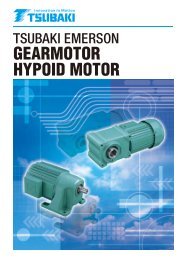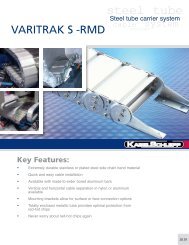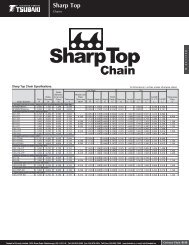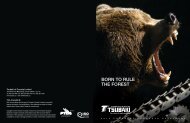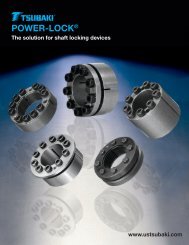Roller Chain - Tsubaki
Roller Chain - Tsubaki
Roller Chain - Tsubaki
Create successful ePaper yourself
Turn your PDF publications into a flip-book with our unique Google optimized e-Paper software.
<strong>Roller</strong> <strong>Chain</strong>Installation & Maintenance5. <strong>Chain</strong> Test RunAfter installing the chain, carry out a test run and check the following items before you actually start running the chain.5.1 Pre-Test Run1) Connecting link plates, clips, and cotter pins are installed correctly.2) <strong>Chain</strong> slack has been properly adjusted.3) Adequate lubrication is available.4) The chain isn’t touching any objects, such as chain cases, etc.5) There are no obstacles in the chain operating area, and all is clean.5.2 Test-Run1) Sound. There should be no strange noises. Make sure the chain doesn’t touch the case.2) Vibration. Look for excessive chain vibration.3) Sprocket-chain interaction. Make sure the chain doesn’t climb over the sprockets.4) Sprockets. Ensure that the chain separates smoothly from the sprocket.5) <strong>Chain</strong> articulation. The chain should articulate smoothly.Drive <strong>Chain</strong>If you notice any of these conditions, do not begin operation. Correct any problems before proceeding any further.6. <strong>Roller</strong> <strong>Chain</strong> Inspection1) <strong>Roller</strong> chain needs to be replaced when parts are damaged or when there has been 1.5% wear elongation. Try to replacethe chain before this kind of situation occurs.2) If roller chain selection and operating conditions are suitable, you can expect long life and low chain maintenance.Eventually the pins and bushings will wear; and the chain will need to be replaced. Listed below is an inspection check list.6.1 Inspection ChecklistTable 3ProceduresStep IStep IIStep IIIMethodVisually check the chainduring operation and lookfor any abnormalities.Stop the chain andcarefully inspect each partof the chain and sprocket.In order to investigate inmore detail, remove theroller chain and inspect itvisually or check it withmeasuring instruments.Inspection Items1. Sound. There should be no strange noises.2. Vibration. Look for excessive chain vibration.3. Sprocket-chain interaction. Make sure the chain doesn’t climb over thesprockets.4. The chain isn’t jammed in the sprockets.5. There are no stiff areas during articulation.6. Adequate lubrication is available (lubricating system and quantity of oil)7. Make sure the chain doesn’t touch the case.1. Check the external cleanliness, corrosive, and lubrication conditions;also look for scratches or other damage to the link plate side and edgesurfaces, pin edges, and roller surfaces.2. Inspect for pin rotation and the clearance between the link plate and thepins.3. Inspect the sprocket teeth surfaces and teeth side surfaces forscratches or marks.4. Measure the wear elongation of the chain.5. Check the articulation of the chain and rotation of the rollers.6. When using a terminating device for lift applications, inspect the wear ofthe end bolts and the wear of the connecting link plate pins. Also checkfor proper installation at the same time.1. The inspection items are identical to those in Step II, however,everything is checked in more detail.Reference page fordetailsInspection pointsare on thefollowing pagesand on thetroubleshootingand problemsolvingpagesA-113



